Birds and People in Medieval Bulgaria—A Review of the Subfossil Record of Birds During the First and Second Bulgarian Empires
Abstract
1. Introduction
2. Scope of the Topic
3. Materials and Methods
| First Bulgarian Empire (681–1018) | |||||
|---|---|---|---|---|---|
| N | Settlement | Province | Age (Century AD) | Avian Species/Domesticated Forms | Source |
| 1. | Garvan | Silistra | 6–11 | Wild: Phasianus colchicus; Domestic: –; | [9] |
| 2. | Popina | Silistra | 8–12 | Wild: –; | [10] |
| Domestic: Gallus gallus domestica | |||||
| 3. | Pliska–Zlatna Niva | Shumen | 10 | Wild: Anser albifrons, Anser anser, Phasianus colchicus, Columba livia, Corvus corax, Otis tarda, Falco peregrinus, Gypaetus barbatus; Domestic: Gallus gallus domestica, Anas platyrhynchos domestica | [11,12] |
| 4. | Pliska–Citadel | Shumen | 10 | Wild: Cygnus olor, Anser anser, Grus grus, Phasianus colchicus, Columba palumbus, Corvus cornix; Domestic: Gallus gallus domestica, Anser anser domestica, Columba livia domestica | [13] |
| 5. | Dolni Lukovit | Pleven | 9–10 | Wild: Columba palumbus; Domestic: Gallus gallus domestica | [14] |
| 6. | Veliki Preslav–Inner Town | Shumen | 9–10 | Wild: Anser fabalis, Anser erythropus, Anser anser, Anser albifrons/fabalis, Anser sp., Anas platyrhynchos, Anas penelope, Tadorna tadorna, Tadorna ferruginea, Anatidae gen., Perdix perdix, Accipiter nisus, Phasianus colchicus, cf. Aquila fasciata, Strix aluco, Corvus cornix, cf. Gyps fulvus, Ardea cinerea/Ardea alba; Domestic: Gallus gallus domestica, Anser anser domestica, Columba livia domestica | [15,16] |
| 7. | Veliki Preslav–Outer Town | Shumen | 9–10 | Wild: Anser erythropus, Anser fabalis, Anas penelope, Anas platyrhynchos, Anser sp., Anatinae gen., Phasianus colchicus, Circaetos gallicus, cf. Columba livia, Aquila fasciata, Strix aluco, Corvus cornix; Domestic: Gallus gallus domestica, Anser anser domestica | [16,17] |
| 8. | Veliki Preslav–Palace Center–North | Shumen | 11–13 | Wild: cf. Alectoris graeca; Domestic: Gallus gallus domestica, Anser anser domestica | [18] |
| 9. | Veliki Preslav–Mostich Monastery | Shumen | 10–12 | Wild: Anser cf. erythropus Domestic: Gallus gallus domestica | [19] |
| 10. | Veliki Preslav–South Gate | Shumen | 9–16 | Wild: –; Domestic: Gallus gallus domestica, Anser anser domestica, Anas platyrhynchos domestica, Meleagris gallopavo domestica | [20] |
| 11. | Serdica–Northern Fortification Wall | Sofia City | 3–6 | Wild: Grus grus, Otis tarda, Gyps fulvus, Buteo buteo; Domestic: Gallus gallus domestica | [21] |
| 12. | Brankovtsi | Vidin | 10–13 | Wild: –; Domestic: Gallus gallus domestica | [22] |
| 13. | Petarch | Sofia | 7–9 | Wild: –; Domestic: Gallus gallus domestica | [23] |
| 14. | Sliven–Hisarlaka | Sliven | 10–12 | Wild: Alectoris graeca, Phasianus colchicus, Alectoris/Perdix; Tetrao urogallus, Buteo buteo, Astur gentilis, Streptopelia turtur, Strix aluco, Otis tarda, Columba livia, cf. Aquila fasciata, Domestic: Gallus gallus domestica, Gallus/Phasianus, Anser anser domestica | [24] |
| 15. | Karnobat–Markeli Fortress | Burgas | 6–11 | Wild: Phasianus colchicus, Otis tarda, Cygnus olor, Clanga clanga, Clanga pomarina, Falco tinnunculus; Domestic: Gallus gallus domestica | [11,25] |
| 16. | Krivnya | Ruse | 9–10 | Wild: Pelecanus onocrotalus, Cygnus olor, Anser anser, Anas platyrhynchos, Phasianus colchicus; Domestic: Gallus gallus domestica, Anser anser domestica, Anas platyrhynchos domestica | [11] |
| 17. | Karanovo | Stara Zagora | 10–12 | Wild: Anser anser, Corvus corax, Clanga pomarina; Domestic: Gallus gallus domestica, Anser anser domestica | [11,25] |
| 18. | Yambol–Necropol | Yambol | 9–12 | Wild: –; Domestic: Gallus gallus domestica, Anser anser domestica | [11,26] |
| 19. | Voden–Voden Cave | Haskovo | 10–14 | Wild: Phasianus colchicus, Pica pica; Domestic:– | [11,26] |
| 20. | Vidin–Baba Vida Fortress | Vidin | 8–17 | Wild: Anas platyrhynchos, Anas sp., Tetrao urogallus, Ardea cinerea, Grus grus, Ciconia ciconia; Domestic: Gallus gallus domestica, Meleagris gallopavo domestica, Anas platyrhynchos domestica | [11,26] |
| 21. | Durankulak | Dobrich | 9–11 | Wild: Cygnus sp., Anser sp., Anas platyrhynchos, Anas sp., Fulica atra, Perdix perdix; Domestic: Gallus gallus domestica, Anas platyrhynchos domestica, Anser anser domestica | [26,27,28] |
| 22. | Ezerovo | Varna | 6–8 | Wild: Cygnus sp.; Domestic: Gallus gallus domestica, Anas platyrhynchos domestica | [29] |
| Second Bulgarian Empire (1185–1396) | |||||
| 23. | Serdica–Forum | Sofia City | 14–19 | Wild: Pelecanus onocrotalus, Anas platyrhynchos, Anas crecca, Tadorna tadorna, Ciconia ciconia, Perdix perdix, Phasianus colchicus, Tetrao urogallus, cf. Otis tarda, Tetrax tetrax, Columba palumbus, Buteo buteo, Aegypius monachus, Gyps fulvus, Aquila chrysaetos, Aquila heliaca, Clanga pomarina, Astur gentilis, Falco cherrug, Corvus cornix, Coloeus monedula; Domestic: Gallus gallus domestica, Anas platyrhynchos domestica, Anser anser domestica, Pavo cristatus domestica, Columba livia domestica, Gallus/Phasianus | [30,31] |
| 24. | Dolni Lukovit | Pleven | 11–14 | Wild: Columba palumbus; Domestic: Gallus gallus domestica | [14] |
| 25. | Brankovtsi | Vidin | 10–13 | Wild: –; Domestic: Gallus gallus domestica | [22] |
| 26. | Karanovo | Stara Zagora | 10–12 | Wild: Anser anser, Corvus corax, Clanga pomarina; Domestic: Gallus gallus domestica, Anser anser domestica | [11,26] |
| 27. | Iskritsa | Stara Zagora | 11–12 | Wild: Anser anser, Perdix perdix, Phasianus colchicus, Otis tarda, Columba livia, Athene noctua Domestic: Gallus gallus domestica | [25] |
| 28. | Dyadovo | Sliven | 11–12 | Wild: Phasianus colchicus, Streptopelia turtur; Domestic: Gallus gallus domestica | [32] |
| 29. | Yambol–Necropol | Yambol | 9–12 | Wild: –; Domestic: Gallus gallus domestica, Anser anser domestica | [11,26] |
| 30. | Yambol–Town | Yambol | 11–14 | Wild: Alectoris graeca, Alectoris/Perdix, Phasianus colchicus, Astur gentilis, Tetrao urogallus, Otis tarda, Streptopelia turtur, Columba livia, Buteo buteo, cf. Aquila fasciata, Strix aluco; Domestic: Gallus gallus domestica, Gallus/Phasianus, Anser anser domestica, Columba livia domestica | [33,34] |
| 31. | Sliven–Hisarlaka | Sliven | 10–12 | Wild: Alectoris graeca, Phasianus colchicus, Gallus/Phasianus, Buteo buteo, Astur gentilis, Tetrao urogallus, Streptopelia turtur, Strix aluco, Otis tarda, Columba livia, cf. Aquila fasciata, Alectoris/Perdix; Domestic: Gallus gallus domestica, Anser anser domestica | [24] |
| 32. | Kovachevo | Pazardzhik | 12 | Wild: –; Domestic: Gallus gallus domestica | [35] |
| 33. | Gledachevo | Stara Zagora | 12 | Wild: Corvus frugilegus; Domestic: Gallus gallus domestica | [25] |
| 34. | Vidin–Baba Vida Fortress | Vidin | 8–17 | Wild: Anas platyrhynchos, Anas sp., Tetrao urogallus, Ardea cinerea, Ciconia ciconia, Grus grus; Domestic: Gallus gallus domestica, Meleagris gallopavo domestica, Anas platyrhynchos domestica | [11,26] |
| 35. | Voden–Voden Cave | Haskovo | 10–14 | Wild: Phasianus colchicus, Pica pica; Domestic: – | [11,26] |
| 36. | Kardzhali–Monastery | Kardzhali | 11–14 | Wild: –; Domestic: Gallus gallus domestica | [36] |
| 37. | Shumen–Fortress | Shumen | 14–15 | Wild: Perdix perdix; Domestic: – | [26] |
4. Results
4.1. First Bulgarian Empire (681–1018 AD)
4.2. Second Bulgarian Empire (1185–1396 AD)
5. Discussion
5.1. Representativeness of Bird Finds
5.2. Birds of Prey
5.3. Synanthropic Birds
5.4. Waterfowl
5.5. Woodland Birds
5.6. Field-Steppe Birds
5.7. Domestic Birds
5.8. Birds in Medieval Bulgarian Art
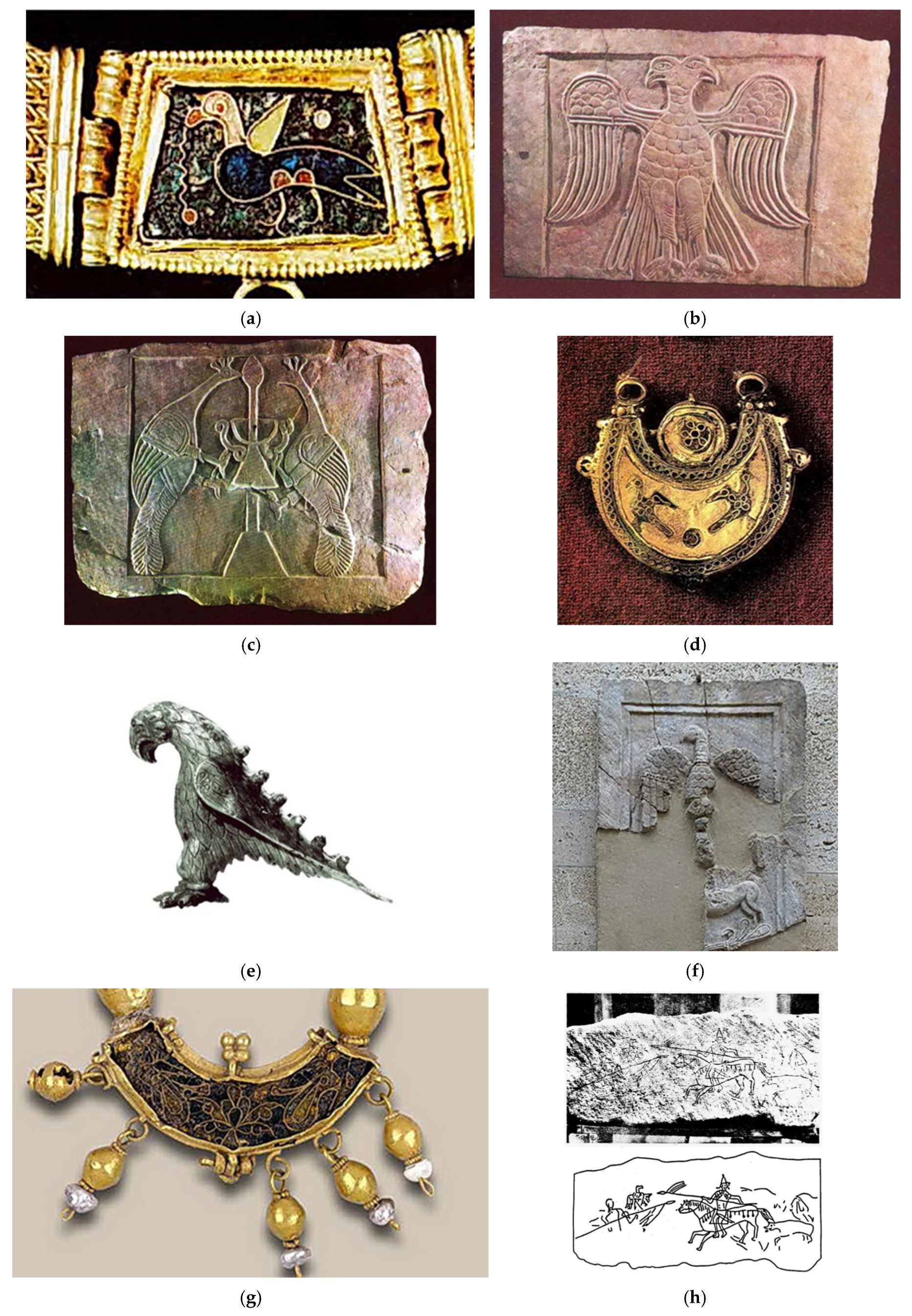
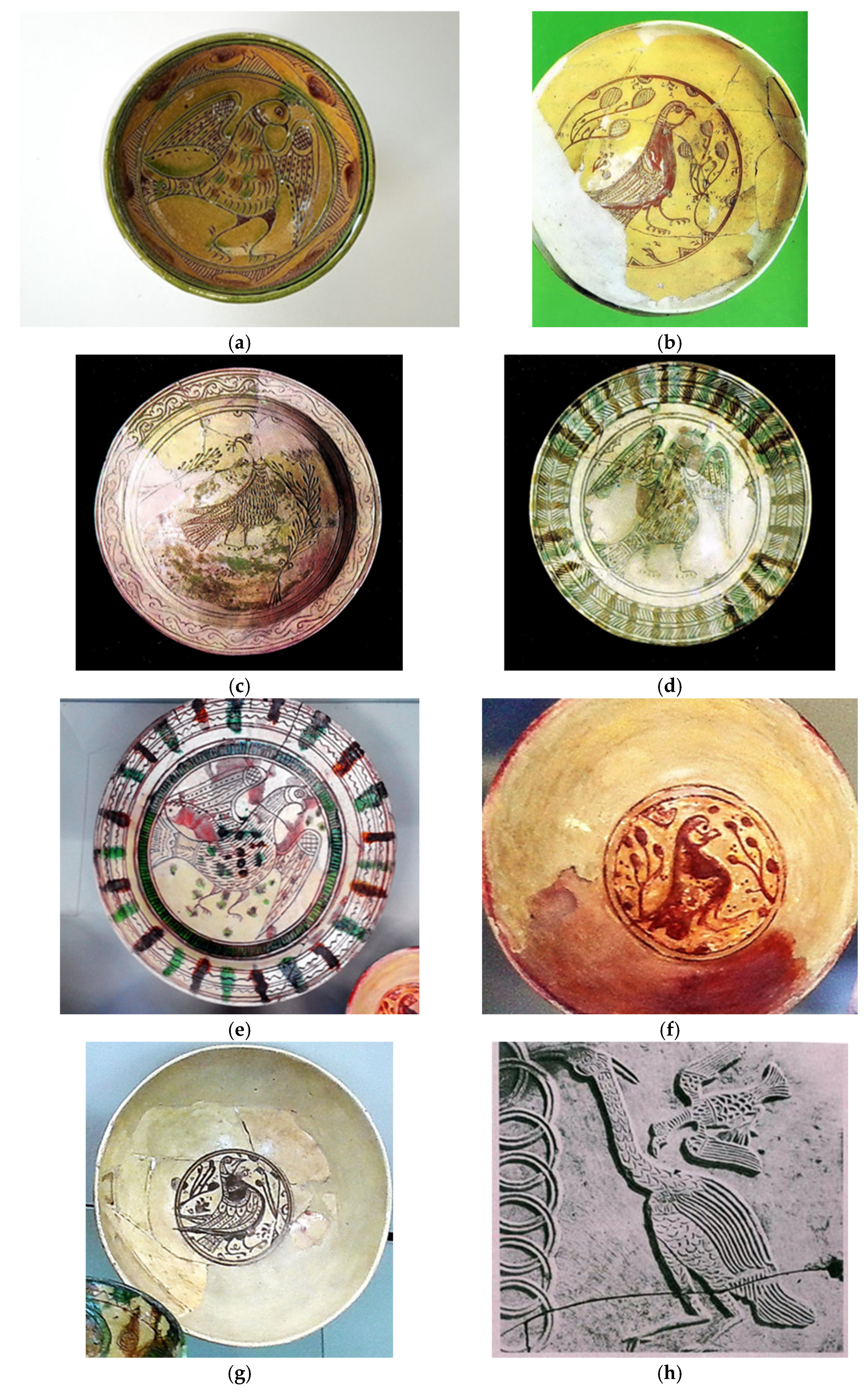
6. Conclusions
Funding
Data Availability Statement
Acknowledgments
Conflicts of Interest
References
- Masseti, M. La Fattoria di Lorenzo il Magnifico. Gli Animali Domestici e Selvatici delle Cascine del Poggio a Caino (Prato): Un Esperimento Pilota nella Gestione delle Risorse Agrosilvopastorali della Toscana del XV Secolo; Centro Educazione del Gusto: Prato, Italy, 2015; Volume XIX, p. 219. [Google Scholar]
- Corbino, C.A.; Albarella, U. Wild birds of the Italian Middle Ages: Diet, environment and society. Environ. Archaeol. 2019, 24, 449–459. [Google Scholar] [CrossRef]
- Berrica, S.; Galindo-Pellicena, M.A.; Barbosa Polanco, J.F.; Casado Gomez, A.I. Explorando las huellas escritas en el pasado. Analisis de los Utiles hallados en el poblado rural de Barajas, Madrid (ss. VII–VIII). Lucentum 2025, 44, 275–290. [Google Scholar] [CrossRef]
- Papalezov, A. Bulgaria Has 400,000 Archaeological Sites, Encroachments on Cultural Heritage Are Decreasing. Available online: https://www.actualno.com/society/bylgarija-ima-400-000-arheologicheski-obekta-posegatelstvata-vyrhu-kulturnoto-nasledstvo-namaljavat-news_628697.html (accessed on 10 April 2025). (In Bulgarian).
- Velkov, V. (Ed.) History of Bulgaria. Vol. 1. Primitive Communal and Slaveholding System. Thracians; BAS: Sofia, Bulgaria, 1979; pp. 1–472. (In Bulgarian) [Google Scholar]
- Fol, A. (Ed.) The Bulgarians—Atlas; Tangra TanNakRa Publishing House, Centre for Research on the Bulgarians: Sofia, Bulgaria, 2001; pp. 1–280. [Google Scholar]
- Ride, W. (Ed.) International Code of Zoological Nomenclature, 4th ed.; The International Trust for Zoological Nomenclature: London, UK; Tipografia La Garangola: Padova, Italy, 1999; p. 306. [Google Scholar]
- Boev, Z. Bone remains of birds. In The Medieval Settlement of the Village of Garvan, Silistra District VI–XI Centuries; Vazharova, Z., Ed.; BAS: Sofia, Bulgaria, 1986; p. 68. (In Bulgarian) [Google Scholar]
- Ivanov, S. Domestic and wild animals from the settlement near the village of Popina, Silistrensko. In Slavic-Bulgarian Settlement Near the Village of Popina–Silistra District; BAS: Sofia, Bulgaria, 1956; pp. 69–95. (In Bulgarian) [Google Scholar]
- Boev, Z. Birds from medieval settlements in Bulgaria. Hist. Nat. Bulg. 1995, 5, 61–67, (In Bulgarian, English Summary). [Google Scholar]
- Boev, Z. New animal remains from Pliska, the medieval capital (10 c. AD) of Bulgaria, (Shumen Region, NE Bulgaria). ZooNotes 2016, 87, 1–3. [Google Scholar]
- Boev, Z. Avian remains from the Palace Center and the Citadel of the medieval capital Pliska of Bulgaria (10th century AD). ZooNotes 2022, 195, 1–4. [Google Scholar]
- Boev, Z. Animal remains of the Late Antiquity settlement (1–4th c. AD) near Dolni Lukovit (Pleven Region, CN Bulgaria). ZooNotes 2023, 222, 1–2. Available online: https://www.researchgate.net/publication/371693125_ (accessed on 25 June 2025).
- Boev, Z.; Iliev, N. Les oiseaux dans la nourriture de la population de la ville interieure de Veliki Preslav (IXe–Xes.). Archeol. BAS 1989, 4, 40–43, (In Bulgarian, French Summary). [Google Scholar]
- Boev, Z.; Iliev, N. Birds and their significance for the inhabitants of Veliki Preslav (IX–X centuries). Archeol. BAS 1991, 3, 43–48, (In Bulgarian, English Summary). [Google Scholar]
- Iliev, N.; Boev, Z. Birds in the food of the inhabitants of the Outer Town of Veliki Preslav (9–10th century). Interdiscip. Stud. BAS 1990, 17, 91–94, (In Bulgarian, English Summary). [Google Scholar]
- Boev, Z. Animal remains from Veliki Preslav (Palace Center—North). 2023; Unpublished work. [Google Scholar]
- Boev, Z. Animal remains from the Monastery of Chargubilya Mostich in Veliki Preslav (10–12th c. AD)—NE Bulgaria. ZooNotes 2025, 255, 1–4. [Google Scholar] [CrossRef]
- Ivanov, S. Die Fleischnahrung der Bewohner am südlichen Stadttor von Preslav. Bull. l’Inst. Archeol. 1959, 22, 209–221. [Google Scholar]
- Boev, Z. New Data on the Fauna of the Late Antiquity Northern Fortification Walls of Serdica (3rd–6th century A.D.) from Building Excavations on Exarch Joseph Street (Sofia, Bulgaria). Bull. Nat. Hist. Mus. 2020, 5, 15–23. [Google Scholar]
- Boev, Z. Animal remains of the medieval settlement near Brankovtsi village (Vidin Region, NW Bulgaria). ZooNotes 2019, 148, 1–4. [Google Scholar]
- Boev, Z. Animal remains of the medieval settlement near Petarch village (Sofia Province, CW Bulgaria). ZooNotes 2021, 184, 1–4. [Google Scholar]
- Boev, Z.; Ribarov, G. Les oiseaux dans la vie des habitants de la localité moyenageuse de Hissarlaka (Sliven), X–XII-es). Bull. Mus. Bulg. Sud-Est 1989, 12, 207–212, (In Bulgarian, French Summary). [Google Scholar]
- Boev, Z. Middle and Late Holocene birds from the Eastern Upper Thracian Plane (S Bulgaria). Hist. Nat. Bulg. 2004, 16, 123–132, (In Bulgarian, English Summary). [Google Scholar]
- Boev, Z. Neogene and Quaternary Birds (Aves) from Bulgaria. Ph.D. Thesis, Bulgarian Academy of Sciences, National Museum of Natural History, Sofia, Bulgaria, 1999. Volume I, Main Part. 243p; Volume II. Supplement 1—Figures, 135 p; Volume II. Supplement 2—Tables, 108p. Available online: https://www.researchgate.net/publication/285176205_Neogene_and_Quaternary_birds_Aves_from_Bulgaria (accessed on 19 February 2025). (In Bulgarian).
- Boev, Z. Wild Galliform and Gruiform Birds (Aves, Galliformes and Gruiformes) in the Archaeological Record of Bulgaria. Int. J. Osteoarchaeol. 1997, 7, 430–439. [Google Scholar] [CrossRef]
- Vasilev, V. Animal husbandry and hunting in the life of the population from the medieval settlement near Durankulak. In Durankulak; Todorova, H., Ed.; BAS: Sofia, Bulgaria, 1989; pp. 223–242. (In Bulgarian) [Google Scholar]
- Ivanov, S. Animal remains from early-medieval necropolises in Varna District. Bull. Nat. Mus. 1976, 12, 159–176. (In Bulgarian) [Google Scholar]
- Boev, Z. Subfossil Vertebrate Fauna from Forum Serdica (Sofia, Bulgaria), 16–18th Century. Acta Zool. Bulg. 2016, 68, 415–424. [Google Scholar]
- Boev, Z. New data on the subfossil fauna from “Forum Serdica” (Sofia City, Bulgaria; 3–19th century A.D.). Hist. Nat. Bulg. 2017, 24, 179–186. [Google Scholar]
- Boev, Z. Avian remains from the Early Bronze Age settlement near Dyadovo village (vicinity of the town of Nova Zagora (Stara Zagora Region, SE Bulgaria). Hist. Nat. Bulg. 2006, 17, 133–135. [Google Scholar]
- Ribarov, G. Cattle breeding in medieval Yambol. Nar. Drugar 1981, 20. [Google Scholar]
- Ribarov, G. Hunting and fishing in medieval Yambol. Nar. Drugar 1981, 20. [Google Scholar]
- Kovachev, G.; Minkov, T. The animal bone material from the medieval settlement near the village of Kovachevo, Pazardzhik District. Interdiscip. Stud. BAS 1979, 3–4, 83–93, (In Bulgarian, English Summary). [Google Scholar]
- Ninov, L. The food of the inhabitants of the monastery in Kardzhali. In The Medieval Monastery in the City of Kardzhali—Center of the Bishopric of Ahridos (11th–14th Centuries); Ovcharov, N., Hadzhieva, N., Eds.; Razkopki i Prouchvaniya, BAS: Sofia, Bulgaria, 1992; Volume 24, pp. 108–113. [Google Scholar]
- Rizoff, D. The Bulgarians in Their Historical, Ethnographical and Political Frontiers; Königliche Hoflithographie, Hof-Buch und Steindruckerei Wilhelm Greve: Berlin, Germany, 1917; pp. 1–110. [Google Scholar]
- Willems, N.M.B.K.; Langenbach, G.E.J.; Everts, V.; Zentner, A. The microstructural and biomechanical development of the condylar bone: A review. Eur. J. Orthod. 2014, 36, 479–485. [Google Scholar] [CrossRef]
- Higgins, J. Túnel: A Case Study of Avian Zooarchaeology and Taphonomy. J. Archaeol. Sci. 1999, 26, 1449–1457. [Google Scholar] [CrossRef]
- del Hoyo, J. (Ed.) All the Birds of the World; Lynx Edicions: Barcelona, Spain, 2020; p. 967. [Google Scholar]
- Mironov, V. The Nocturnal Bird That Used to Be Eaten Throughout the US. 2024. Available online: https://www.foodrepublic.com/1691804/owl-meat-banned-eating-us/ (accessed on 10 April 2025).
- Boev, N. Materiaux sur l’etendue de l’habitat eT la biologie de la “Tourterelle turque” (Streptopelia decaocto Frivaldszkyj en Bulgarie). Bull. l’Inst. Zool. Mus. 1963, 13, 5–31, (In Bulgarian, French Summary). [Google Scholar]
- Dončev, S.; Iankov, P. State and tendencies of synanthropization and synurbanization of birds in Bulgaria. Ecology 1989, 22, 35–42, (In Russian, English Summary). [Google Scholar]
- Besarabova, S. The Common Crane Nests Again in Bulgaria, After Being Absent from South-Eastern Europe for Decades. 2023. Available online: https://faktor.bg/bg/articles/novini-balgariya-siviyat-zherav-otnovo-svi-gnezdo-v-balgariya-sled-kato-desetiletiya-otsastvashe-ot-yugoiztochna-evropa (accessed on 19 February 2025).
- Fokas, D. On the nature of lifelike images in medieval Bulgarian art. In Images of Animals and Fantastic Creatures in the Art of the Bulgarian Lands XI–XIV Century; Academic Publishing House “Prof. Marin Drinov”: Sofia, Bulgaria, 2024; pp. 26–40, (In Bulgarian, English Summary). [Google Scholar]
- Chilingirov, A. The Works of Byzantine Fine Art and Artistic Crafts from the X–XII Century and Bulgarian Fine Art; Online Edition of Manuscript Rights; First Published on the Portal “Ot izvora” 2013, © Assen Chilingirov; Ot izvora: Berlin, Germany, 2013; pp. 1–94. (In Bulgarian) [Google Scholar]
- Yordanova, T. Images of animals in Old Bulgarian art. Priroda 1981, 5, 9–16. (In Bulgarian) [Google Scholar]
- Ivanov, T.; Minkova, M. Once again about the medieval stone reliefs from Stara Zagora. Bull. Hist. Mus. 2008, 8, 177–184. (In Bulgarian) [Google Scholar]
- Bozhkov, A. Bulgarian Fine Art; Septemvri Publishing House: Sofia, Bulgaria, 1988; pp. 1–549. (In Bulgarian) [Google Scholar]
- Voznesenka Threasure. 2025. Available online: https://historybg.info/%D0%B2%D0%BE%D0%B7%D0%BD%D0%B5%D1%81%D0%B5%D0%BD%D1%81%D0%BA%D0%BE-%D1%81%D1%8A%D0%BA%D1%80%D0%BE%D0%B2%D0%B8%D1%89%D0%B5/ (accessed on 18 February 2025).
- Ovcharov, N. The Incredible Works of Sculpture in Bulgaria in the 9th–10th Centuries. The Stone Beauty of Simeon’s Capital. 2023. Available online: https://trud.bg/%D0%BA%D0%B0%D0%BC%D0%B5%D0%BD%D0%BD%D0%B0%D1%82%D0%B0-%D0%BA%D1%80%D0%B0%D1%81%D0%BE%D1%82%D0%B0-%D0%BD%D0%B0-%D1%81%D0%B8%D0%BC%D0%B5%D0%BE%D0%BD%D0%BE%D0%B2%D0%B0%D1%82%D0%B0-%D1%81%D1%82%D0%BE%D0%BB%D0%B8%D1%86%D0%B0/ (accessed on 18 February 2025).
- Earpiece from the Preslav Treasure. 2025. Available online: https://www.pinterest.com/pin/421719952623887057/#imgViewer (accessed on 18 February 2025).
- Feher, G. The Role and Culture of the Proto-Bulgarians. The Importance of Proto-Bulgarian and Old Hungarian Culture in Building the Civilization of Eastern Europe; Ivan Koyumdzhiev Publishing House: Sofia, Bulgaria, 1939; pp. 1–171. (In Bulgarian) [Google Scholar]
- Angelov, N. The Art Ceramics from the City of Tirnovo; Set of 11 Photo Cards; Fotoizdat Publishing House: Sofia, Bulgaria, 1974; (In Bulgarian, English Summary). [Google Scholar]
- Falconry in Bulgaria. 2025. Available online: https://www.sokolarstvo.eu/istoria-i-zakoni-sokolarstvo/sokolarstvoto-v-bulgaria.html (accessed on 18 February 2025).
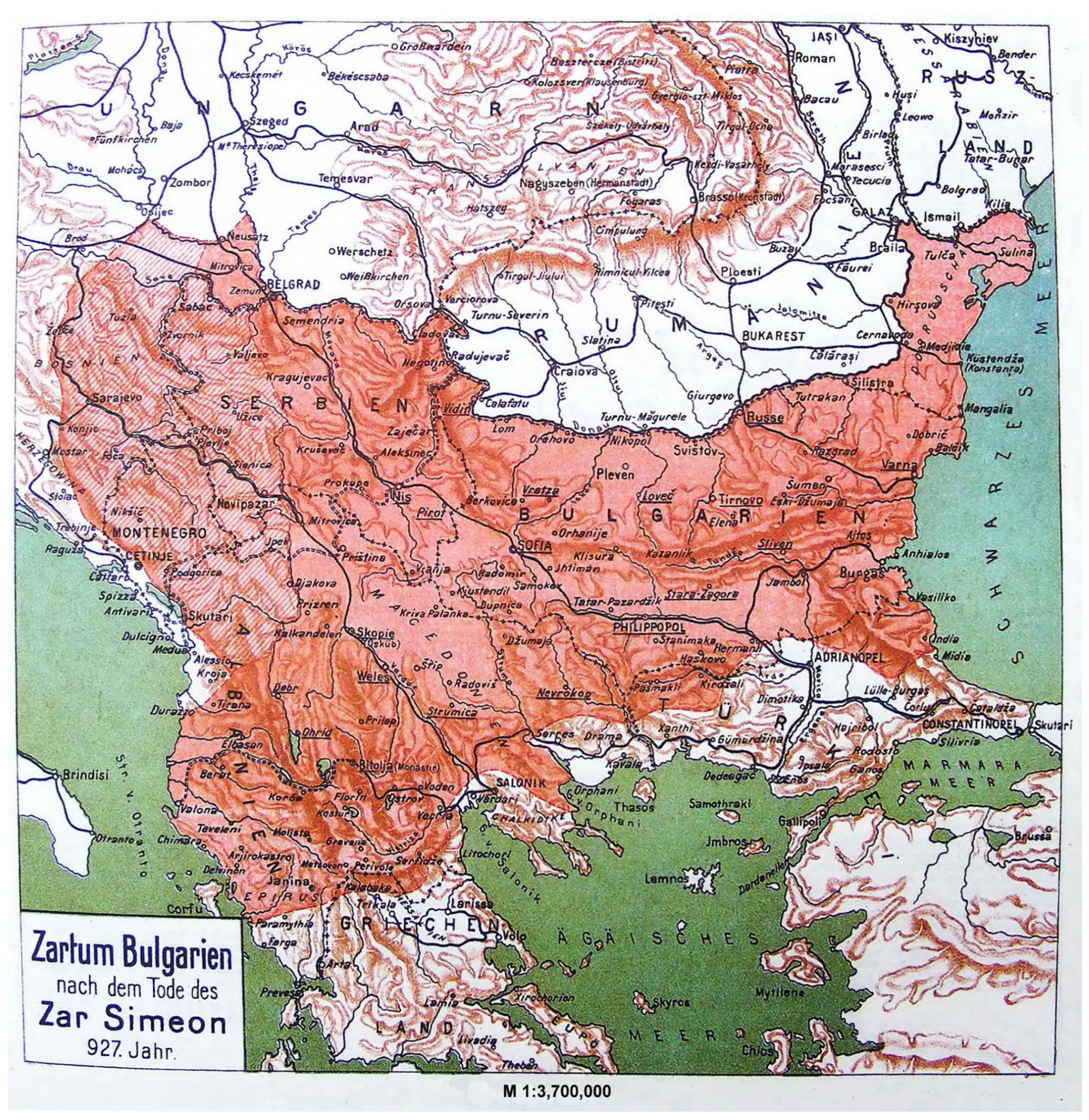
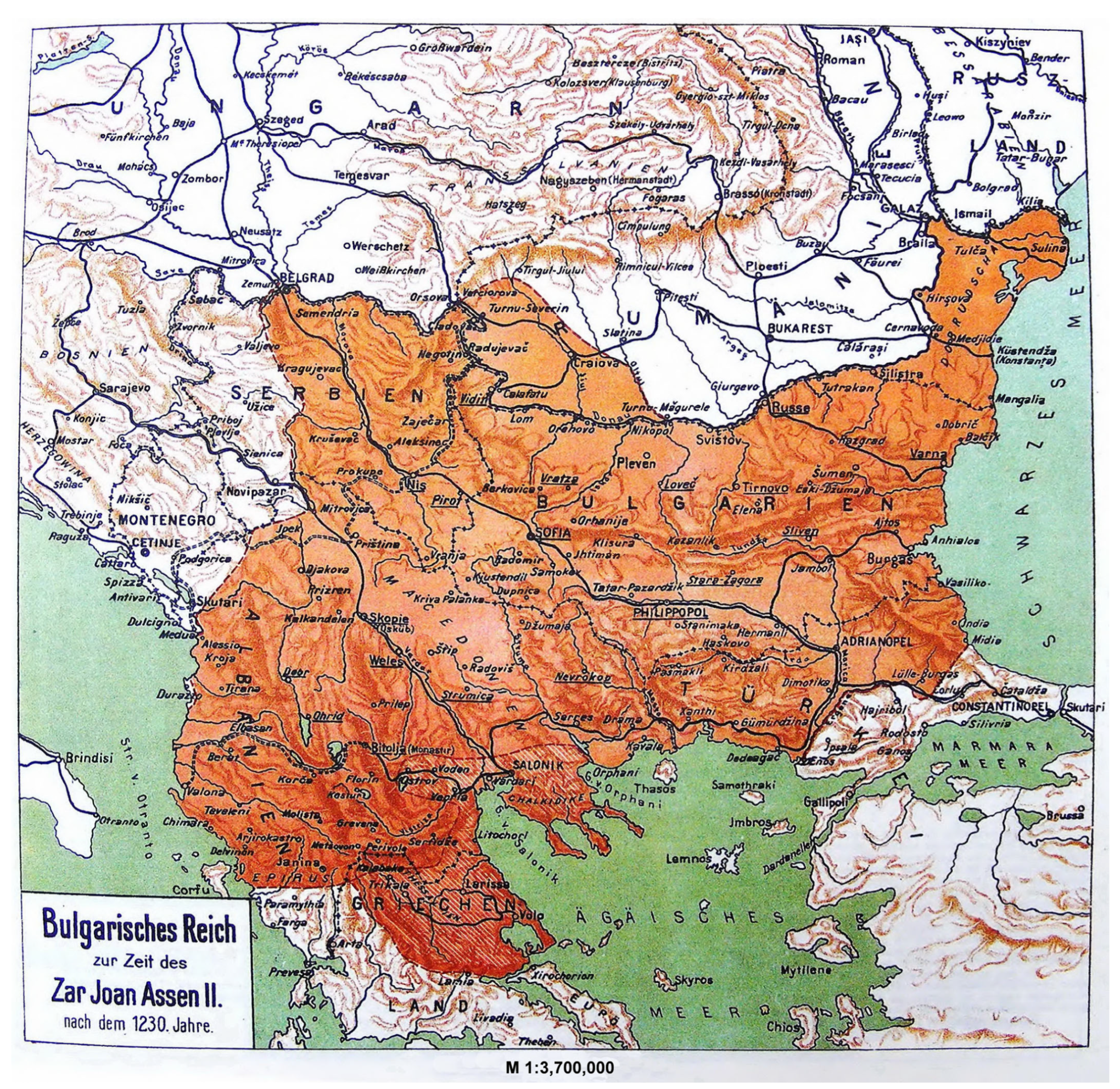
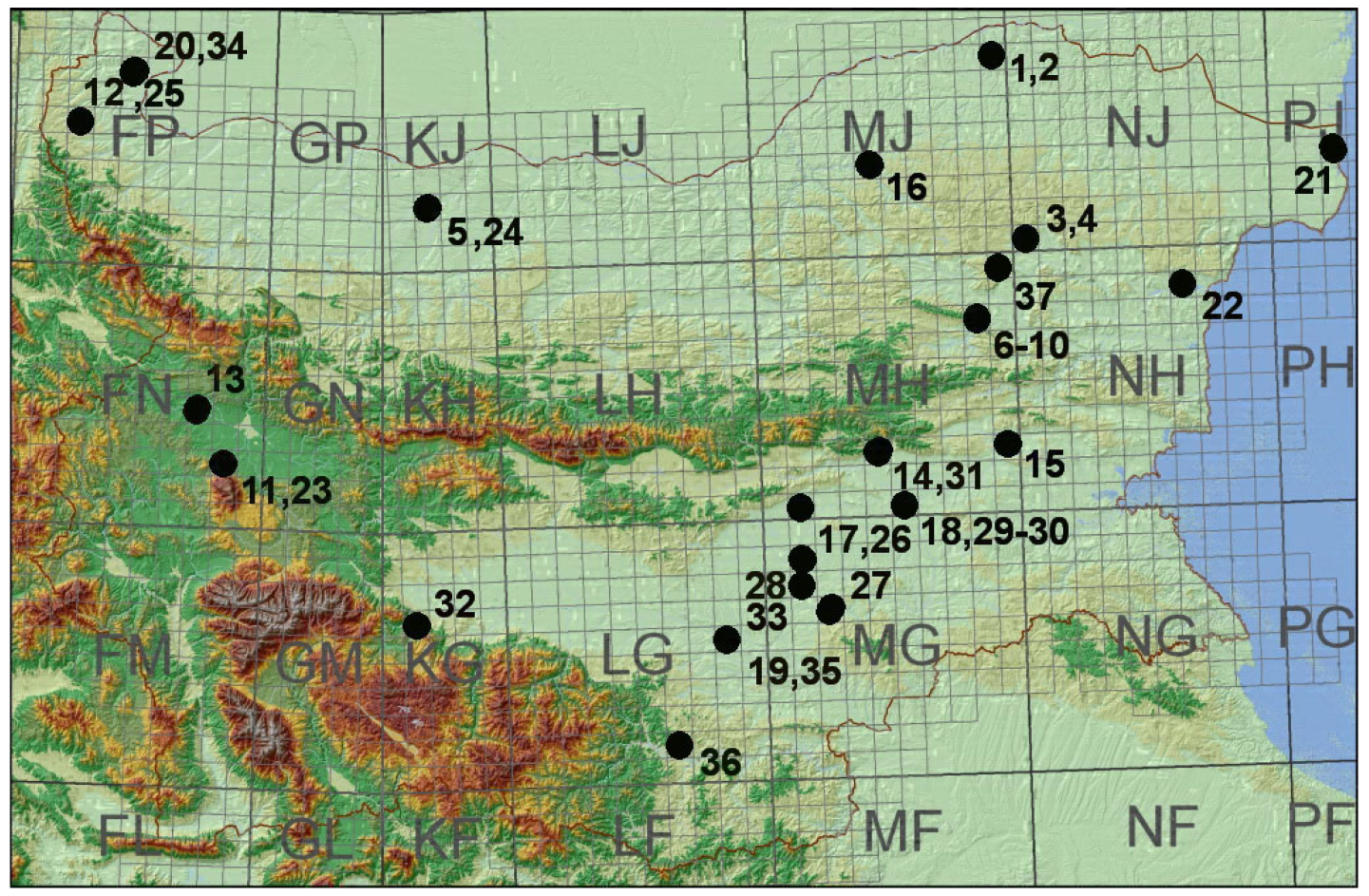
| First Bulgarian Empire (681–1018 AD) | Second Bulgarian Empire (1185–1396 AD) | ||
|---|---|---|---|
| 1. | Astur gentilis | 1. | Astur gentilis |
| 2. | Accipiter nisus | 2. | - |
| 3. | - | 3. | Aegypius monachus |
| 4. | Alectoris graeca | 4. | Alectoris graeca |
| 5. | Alectoris/Perdix | 5. | Alectoris/Perdix |
| 6. | Anas penelope | 6. | - |
| 7. | - | 7. | Anas crecca |
| 8. | Anas platyrhynchos | 8. | Anas platyrhynchos |
| 9. | Anas platyrhynchos domestica | 9. | Anas platyrhynchos domestica |
| 10. | Anas sp. | 10. | Anas sp. |
| 11. | Anatidae gen. | 11. | - |
| 12. | Anser anser | 12. | Anser anser |
| 13. | Anser albifrons | 13. | - |
| 14. | Anser anser domestica | 14. | Anser anser domestica |
| 15. | Anser albifrons/fabalis | 15. | - |
| 16. | Anser erythropus | 16. | - |
| 17. | Anser fabalis | 17. | - |
| 18. | Anser sp. | 18. | - |
| 19. | - | 19. | Athene noctua |
| 20. | Ardea cinerea | 20. | Ardea cinerea |
| 21. | Ardea cinerea/Ardea alba | 21. | - |
| 22. | - | 22. | Aquila heliaca |
| 23. | - | 23. | Aquila chrysaetos |
| 24. | Circaetos gallicus | 24. | - |
| 25. | Buteo buteo | 25. | Buteo buteo |
| 26. | Ciconia ciconia | 26. | Ciconia ciconia |
| 27. | Aquila fasciata | 27. | Aquila fasciata |
| 28. | Clanga pomarina | 28. | Clanga pomarina |
| 29. | Clanga clanga | 29. | - |
| 30. | - | 30. | Coloeus monedula |
| 31. | Columba livia | 31. | Columba livia |
| 32. | Columba livia domestica | 32. | Columba livia domestica |
| 33. | Columba palumbus | 33. | Columba palumbus |
| 34. | Corvus corax | 34. | Corvus corax |
| 35. | Corvus cornix | 35. | Corvus cornix |
| 36. | - | 36. | Corvus frugilegus |
| 37. | - | 37. | Falco cherrug |
| 38. | Falco peregrinus | 38. | - |
| 39. | Falco tinnunculus | 39. | - |
| 40. | - | 40. | Gallus/Phasianus |
| 41. | Grus grus | 41. | Grus grus |
| 42. | Cygnus olor | 42. | - |
| 43. | - | 43. | Gyps fulvus |
| 44. | Cygnus sp. | 44. | - |
| 45. | - | 45. | Meleagris gallopavo domestica |
| 46. | Otis tarda | 46. | Otis tarda |
| 47. | - | 47. | Pavo cristatus domestica |
| 48. | - | 48. | Pelecanus onocrotalus |
| 49. | Fulica atra | 49. | - |
| 50. | Perdix perdix | 50. | Perdix perdix |
| 51. | Gallus gallus domestica | 51. | Gallus gallus domestica |
| 52. | Gallus/Phasianus | 52. | - |
| 53. | - | 53. | Phasianus colchicus |
| 54. | Pica pica | 54. | Pica pica |
| 55. | Gypaetus barbatus | 55. | - |
| 56. | Streptopelia turtur | 56. | Streptopelia turtur |
| 57. | Gyps fulvus | 57. | - |
| 58. | Tadorna tadorna | 58. | Tadorna tadorna |
| 59. | Tadorna ferruginea | 59. | - |
| 60. | Tetrao urogallus | 60. | Tetrao urogallus |
| 61. | - | 61. | Tetrax tetrax |
| 62. | Pelecanus onocrotalus | 62. | - |
| 63. | Phasianus colchicus | 63. | - |
| 64. | Strix aluco | 64. | Strix aluco |
Disclaimer/Publisher’s Note: The statements, opinions and data contained in all publications are solely those of the individual author(s) and contributor(s) and not of MDPI and/or the editor(s). MDPI and/or the editor(s) disclaim responsibility for any injury to people or property resulting from any ideas, methods, instructions or products referred to in the content. |
© 2025 by the author. Licensee MDPI, Basel, Switzerland. This article is an open access article distributed under the terms and conditions of the Creative Commons Attribution (CC BY) license (https://creativecommons.org/licenses/by/4.0/).
Share and Cite
Boev, Z. Birds and People in Medieval Bulgaria—A Review of the Subfossil Record of Birds During the First and Second Bulgarian Empires. Quaternary 2025, 8, 36. https://doi.org/10.3390/quat8030036
Boev Z. Birds and People in Medieval Bulgaria—A Review of the Subfossil Record of Birds During the First and Second Bulgarian Empires. Quaternary. 2025; 8(3):36. https://doi.org/10.3390/quat8030036
Chicago/Turabian StyleBoev, Zlatozar. 2025. "Birds and People in Medieval Bulgaria—A Review of the Subfossil Record of Birds During the First and Second Bulgarian Empires" Quaternary 8, no. 3: 36. https://doi.org/10.3390/quat8030036
APA StyleBoev, Z. (2025). Birds and People in Medieval Bulgaria—A Review of the Subfossil Record of Birds During the First and Second Bulgarian Empires. Quaternary, 8(3), 36. https://doi.org/10.3390/quat8030036







